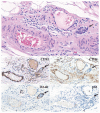Updates on Lymphovascular Invasion in Breast Cancer
- PMID: 36979946
- PMCID: PMC10046167
- DOI: 10.3390/biomedicines11030968
Updates on Lymphovascular Invasion in Breast Cancer
Abstract
Traditionally, lymphovascular invasion (LVI) has represented one of the foremost pathological features of malignancy and has been associated with a worse prognosis in different cancers, including breast carcinoma. According to the most updated reporting protocols, the assessment of LVI is required in the pathology report of breast cancer surgical specimens. Importantly, strict histological criteria should be followed for LVI assessment, which nevertheless is encumbered by inconsistency in interpretation among pathologists, leading to significant interobserver variability and scarce reproducibility. Current guidelines for breast cancer indicate biological factors as the main determinants of oncological and radiation therapy, together with TNM staging and age. In clinical practice, the widespread use of genomic assays as a decision-making tool for hormone receptor-positive, HER2-negative breast cancer and the subsequent availability of a reliable prognostic predictor have likely scaled back interest in LVI's predictive value. However, in selected cases, the presence of LVI impacts adjuvant therapy. This review summarizes current knowledge on LVI in breast cancer with regard to definition, histopathological assessment, its biological understanding, clinicopathological association, and therapeutic implications.
Keywords: LVI; angioinvasion; breast cancer; breast carcinoma; lymphovascular invasion; prognosis.
Conflict of interest statement
The authors declare no conflict of interest.
Figures


References
-
- Mohammed R.A., Martin S.G., Mahmmod A.M., Macmillan R.D., Green A.R., Paish E.C., Ellis I.O. Objective assessment of lymphatic and blood vascular invasion in lymph node-negative breast carcinoma: Findings from a large case series with long-term follow-up. J. Pathol. 2011;223:358–365. doi: 10.1002/path.2810. - DOI - PubMed
-
- Torous V.F., Simpson R.W., Balani J.P., Baras A.S., Berman M.A., Birdsong G.G., Giannico G.A., Paner G.P., Pettus J.R., Sessions Z., et al. College of American Pathologists Cancer Protocols: From Optimizing Cancer Patient Care to Facilitating Interoperable Reporting and Downstream Data Use. JCO Clin. Cancer Inf. 2021;5:47–55. doi: 10.1200/CCI.20.00104. - DOI - PMC - PubMed
-
- Fitzgibbons P., Connolly J., Bose S. Protocol for the examination of resection specimens from patients with invasive carcinoma of the breast. Coll. Am. Pathol. 2020;4:1515–1538. - PubMed
-
- Goldhirsch A., Wood W.C., Coates A.S., Gelber R.D., Thürlimann B., Senn H.J., Panel members Strategies for subtypes—Dealing with the diversity of breast cancer: Highlights of the St. Gallen International Expert Consensus on the Primary Therapy of Early Breast Cancer 2011. Ann. Oncol. 2011;22:1736–1747. doi: 10.1093/annonc/mdr304. - DOI - PMC - PubMed
Publication types
LinkOut - more resources
Full Text Sources
Research Materials
Miscellaneous

